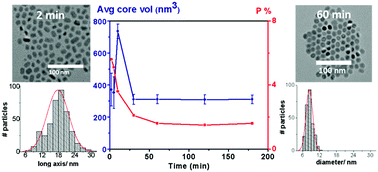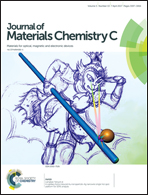Solution-phase growth mechanism of phosphorus-doped MnAs nanoparticles: size, polydispersity and dopant control on the nanoscale†
Abstract
MnAs exhibits a large magnetocaloric effect associated with the first-order phase transition at 315 K, making it a promising phase for near-room-temperature magnetic refrigeration technologies. Optimization of the properties to expand the temperature range of operation (by adjusting the phase transition temperature) and reduce hysteresis losses can be achieved by phosphorus-doping and nanostructuring, respectively. The synthesis of P-doped MnAs as discrete nanoparticles by rapid injection synthesis has been previously reported, but suffers from extensive polydispersity and an inability to independently control size and dopant concentration. In the present work, a kinetic analysis of the P-doped MnAs nanoparticle formation by temporal correlation of particle volume, P-dopant concentration, and particle size to monomer concentration, is undertaken. Narrow polydispersity samples can only be obtained by rapid quenching from the reaction temperature, achieved by injection of the hot solution into cold chloroform; cooling in the flask leads to polydispersity characteristic of Ostwald ripening. When isolated at high temperature, particles initially grow at high monomer concentrations, achieving volumes of ca. 740 nm3 by 10 min, and then decrease in volume by more than a factor of two by 30 min reaction time, at which point both the size and residual monomer concentration (ca. 20%) remain constant, suggesting formation of an equilibrium or an unreactive byproduct. Simultaneously, the concentration of P incorporated is found to decrease over the time of the reaction from 5–7% initially to a nearly constant concentration of <2% by 60 min. These data suggest that P is incorporated preferentially at the nucleation stage, but is lost over time. This detailed understanding of MnAs particle formation and P-inclusion enables independent assessment of the role of size, polydispersity, and dopant concentration on magnetic properties.



 Please wait while we load your content...
Please wait while we load your content...